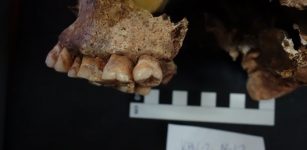Legendary ‘Orichalcum Metal’ Related To Atlantis Found In 2,600-Year-Old Shipwreck
MessageToEagle.com – A shipwreck sunk 2,600 years ago, off the coast of Gela in southern Sicily and the story of this ship is still fascinating today.
The ship – dated to the first half of the sixth century – was on its way to Gela in Sicily, possibly coming from Greece or Asia Minor.

It was carrying ingots of orichalcum, ancient gleaming metal, which according to ancient Greeks was supposed to be mined in the legendary Atlantis, a land we have never been able to localize.
In 2015, underwater archaeologists recovered 39 orichalcum lumps from the shipwreck and earlier this month, additionally 47 pieces of this precious alloy have emerged from the seas of Sicily, reports Seeker.

“The ship dates to the end the sixth century B.C.,” said Sebastiano Tusa, an archaeologist and and Sicily’s superintendent of the sea, said.
“It was likely caught in a sudden storm and sunk just when it was about to enter the port.”
According to the ancient Greeks, it was invented by Cadmus, a Greek-Phoenician mythological character. The fourth century B.C. Greek philosopher Plato made orichalcum a legendary metal when he mentioned it in the Critias dialogue (460-403 BC).
See also:
Orichalcum: Mysterious Metal Linked To Legendary Atlantis Discovered In Shipwreck
Hyperborea Or Atlantis Ruins – Underground Secrets Of The Sacred Lake On The Arctic Circle
Bolivia And The Mystery Of The Twins Of Atlantis
Plato wrote that the metal, second only in value to gold, was mined in Atlantis and was used to cover Poseidon’s temple interior walls, columns and floors. A legend says that the temple stood on pillar made of orichalcum and inscribed with Poseidon’s laws.
Today, most scholars agree orichalcum is a brass-like alloy, which was made in antiquity by cementation. This process was achieved with the reaction of zinc ore, charcoal and copper metal in a crucible.
Using X-ray fluorescence, researchers have analyzed the 39 ingots and concluded that they are made with 75-80 percent copper, 15-20 percent zinc and small percentages of nickel, lead and iron.
This brass-like alloy was perhaps not as precious as Plato described it; however, it was valuable enough to be used by skilled craftsmen in workshops of the ancient city of Gela.
MessageToEagle.com
Related Posts
-
 Unique 3,000-Year-Old Script Discovered In Georgia Re-Writes Ancient History
No Comments | Jul 27, 2016
Unique 3,000-Year-Old Script Discovered In Georgia Re-Writes Ancient History
No Comments | Jul 27, 2016 -
 ‘Face Of First European’ – Oldest Fossil Of European Human Ancestor Found At Spain’s Atapuerca Archaeological Site
No Comments | Jul 12, 2022
‘Face Of First European’ – Oldest Fossil Of European Human Ancestor Found At Spain’s Atapuerca Archaeological Site
No Comments | Jul 12, 2022 -
 Swinegate Finds: Young Viking Era Woman Buried Beneath Lost Church Could Have Lived 999 Years Ago
No Comments | Dec 6, 2015
Swinegate Finds: Young Viking Era Woman Buried Beneath Lost Church Could Have Lived 999 Years Ago
No Comments | Dec 6, 2015 -
 Long-Lost Grave Of Attalid Rulers Discovered In Turkey
No Comments | Jun 21, 2016
Long-Lost Grave Of Attalid Rulers Discovered In Turkey
No Comments | Jun 21, 2016 -
 15,000-Year-Old Petroglyphs Discovered In The Gobi Desert May Be Evidence Ancient Turks Visited Mongolia – Expert Says
No Comments | Apr 5, 2022
15,000-Year-Old Petroglyphs Discovered In The Gobi Desert May Be Evidence Ancient Turks Visited Mongolia – Expert Says
No Comments | Apr 5, 2022 -
 Rare Medieval Copy Of Fresco Discovered In Ruined Transylvanian Church
No Comments | Mar 1, 2016
Rare Medieval Copy Of Fresco Discovered In Ruined Transylvanian Church
No Comments | Mar 1, 2016 -
 Urartian Noble Woman Buried With Jewelry Found In 2,750-Year-Old Necropolis Of Çavuştepe Castle
No Comments | Sep 10, 2020
Urartian Noble Woman Buried With Jewelry Found In 2,750-Year-Old Necropolis Of Çavuştepe Castle
No Comments | Sep 10, 2020 -
 Milk Enabled Massive Steppe Migration
No Comments | Sep 17, 2021
Milk Enabled Massive Steppe Migration
No Comments | Sep 17, 2021 -
 Archaeological Discovery Of “Once-In-A-Lifetime” Medieval Gold Necklace In Britain
No Comments | Dec 9, 2022
Archaeological Discovery Of “Once-In-A-Lifetime” Medieval Gold Necklace In Britain
No Comments | Dec 9, 2022 -
 1,500-Year-Old Joint Burial Offers A Look Into Attitudes Toward Love And The Afterlife
No Comments | Sep 14, 2021
1,500-Year-Old Joint Burial Offers A Look Into Attitudes Toward Love And The Afterlife
No Comments | Sep 14, 2021
